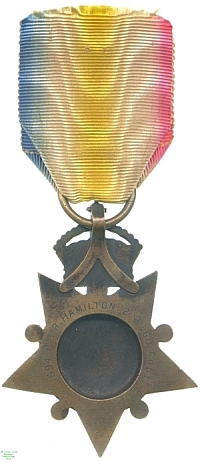
Obverse, the royal monogram in centre with inscription around, on a downward five-pointed bronze star with balls between the points, the uppermost being surmounted by a crown

Reverse, inscription around the central cavity

Obverse, the royal monogram in centre with inscription around, on a downward five-pointed bronze star with balls between the points, the uppermost being surmounted by a crown |

Reverse, inscription around the central cavity |
After the initial British success against Amir Sher Ali in Afghanistan in 1878, a British resident was installed in Kabul in 1879, the Amir being sworn (and paid a considerable subsidy) to behave friendlily towards him. This proved no protection against the Resident's murder along with other British residents in September 1879, whereupon war was rejoined.
After a very brief cessation of conflict, in July 1880 Sher Ali's nephew Abdur Rahman was proclaimed Amir by the British, whereupon his cousin Ayub Khan, brother of Shere Ali's son who had been proclaimed by the Afghans in the previous year, rebelled and defeated a British force sent to oppose him at Maiwand. The remains of this force retired back to Kandahar where they were heavily besieged for a month before relief could arrive from Kabul. The relief force, which covered the 110 miles between the two forts in 22 days, and defeated the Afghan army the very next day, which led Queen Victoria to approve the issue of a bronze star for membership of it in 1881. The star, in an echo of the Victoria Cross, was struck from the metal of Afghan guns captured at Kandahar in that decisive battle.
One recipient of the medal was Private R. Hamilton, of the 2nd Battalion, 60th Foot. Lester Watson purchased his medal from the London dealer Baldwin at some point before 1928.